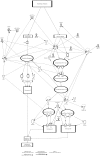MicroRNAs: The Missing Link in the Biology of Graft-Versus-Host Disease?
- PMID: 24348483
- PMCID: PMC3845018
- DOI: 10.3389/fimmu.2013.00420
MicroRNAs: The Missing Link in the Biology of Graft-Versus-Host Disease?
Abstract
Graft-versus-host disease (GVHD) is still the major complication of allogeneic hematopoietic stem cell transplantation. Despite extensive studies in understanding the pathophysiology of GVHD, its pathogenesis remains unclear. Recently, important functions of microRNAs have been demonstrated in various autoimmune diseases and cancers such as psoriasis and lymphoma. This review highlights the need to investigate the role of microRNAs in GVHD and hypothesizes that microRNAs may be one of the missing links in our understanding of GVHD, with the potential for novel therapeutics.
Keywords: allogeneic hematopoietic stem cell transplantation; bioinformatics; biomarkers; graft-versus-host disease; microRNAs.
Figures




Similar articles
-
MicroRNAs as biomarkers for graft-versus-host disease following allogeneic stem cell transplantation.Ann Hematol. 2015 Jul;94(7):1081-92. doi: 10.1007/s00277-015-2369-0. Epub 2015 Apr 22. Ann Hematol. 2015. PMID: 25900787 Review.
-
Exosomal miRNA Signatures for Late-Onset Acute Graft-Versus-Host Disease in Allogenic Hematopoietic Stem Cell Transplantation.Int J Mol Sci. 2018 Aug 23;19(9):2493. doi: 10.3390/ijms19092493. Int J Mol Sci. 2018. PMID: 30142940 Free PMC article.
-
Hematopoietic stem cell graft manipulation as a mechanism of immunotherapy.Int Immunopharmacol. 2003 Aug;3(8):1121-43. doi: 10.1016/S1567-5769(03)00014-6. Int Immunopharmacol. 2003. PMID: 12860168 Review.
-
Circulating miRNA panel for prediction of acute graft-versus-host disease in lymphoma patients undergoing matched unrelated hematopoietic stem cell transplantation.Exp Hematol. 2016 Jul;44(7):624-634.e1. doi: 10.1016/j.exphem.2016.03.005. Epub 2016 Mar 21. Exp Hematol. 2016. PMID: 27013207
-
[Biomarkers of graft-versus-host disease following allogeneic hematopoietic cell transplantation].Rinsho Ketsueki. 2020;61(4):379-386. doi: 10.11406/rinketsu.61.379. Rinsho Ketsueki. 2020. PMID: 32378584 Japanese.
Cited by
-
miR-625-3p is upregulated in CD8+ T cells during early immune reconstitution after allogeneic stem cell transplantation.PLoS One. 2017 Aug 30;12(8):e0183828. doi: 10.1371/journal.pone.0183828. eCollection 2017. PLoS One. 2017. PMID: 28854245 Free PMC article.
-
Genetic Association of Hematopoietic Stem Cell Transplantation Outcome beyond Histocompatibility Genes.Front Immunol. 2017 Apr 3;8:380. doi: 10.3389/fimmu.2017.00380. eCollection 2017. Front Immunol. 2017. PMID: 28421078 Free PMC article. Review.
-
MicroRNAs in graft-versus-host disease: a review of the latest data.Bone Marrow Transplant. 2020 Jun;55(6):1014-1020. doi: 10.1038/s41409-019-0764-1. Epub 2019 Dec 3. Bone Marrow Transplant. 2020. PMID: 31796872 Review.
-
The Role of MicroRNA in Graft-Versus-Host-Disease: A Review.Genes (Basel). 2023 Sep 13;14(9):1796. doi: 10.3390/genes14091796. Genes (Basel). 2023. PMID: 37761936 Free PMC article. Review.
-
Tissue-Specific Expression Patterns of MicroRNA during Acute Graft-versus-Host Disease in the Rat.Front Immunol. 2016 Sep 16;7:361. doi: 10.3389/fimmu.2016.00361. eCollection 2016. Front Immunol. 2016. PMID: 27695455 Free PMC article.
References
-
- Schmitz N, Dreger P, Suttorp M, Rohwedder EB, Haferlach T, Loffler H, et al. Primary transplantation of allogeneic peripheral blood progenitor cells mobilized by filgrastim (granulocyte colony-stimulating factor). Blood (1995) 85:1666–72 - PubMed
Publication types
LinkOut - more resources
Full Text Sources
Other Literature Sources

